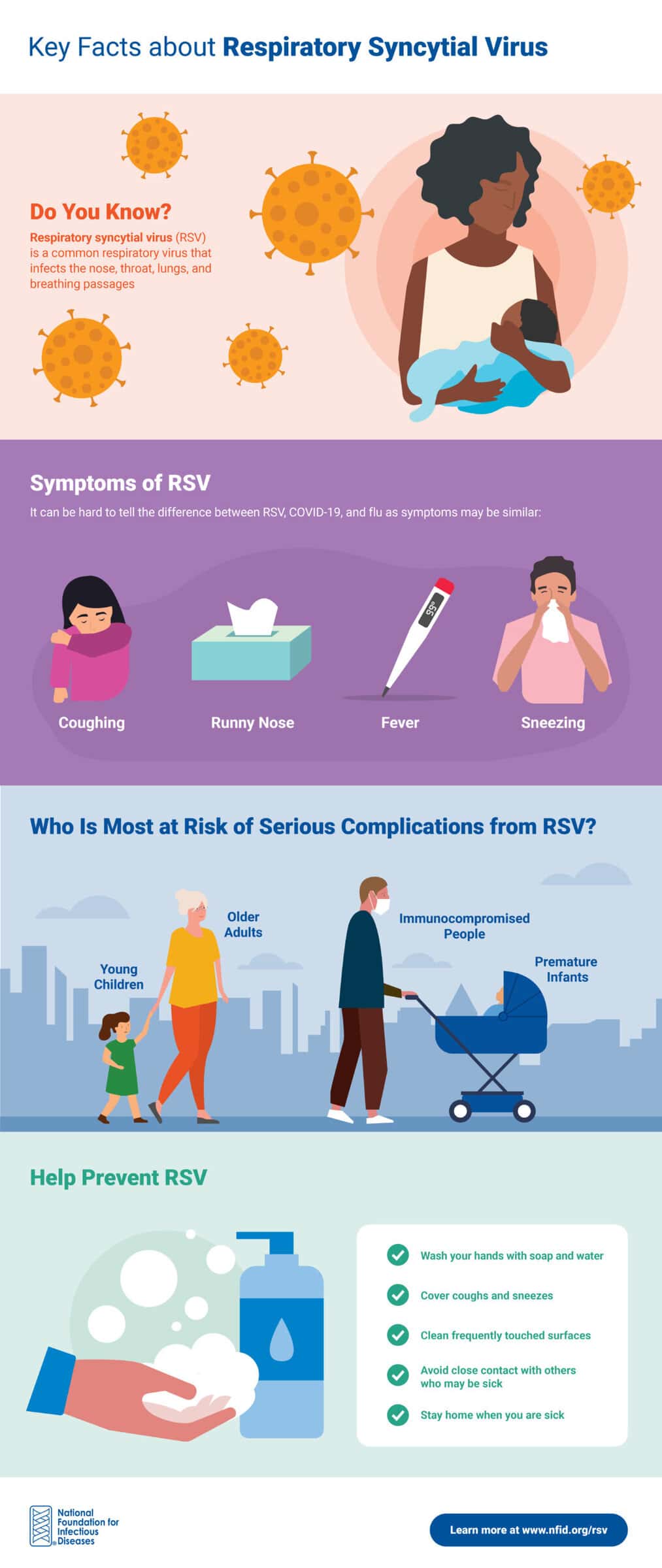
If you are suddenly hearing a lot about respiratory syncytial virus (RSV), it is because the virus has come earlier and hit harder than in most years, and is currently surging and straining children’s hospitals across the US …
DC-area children’s hospitals are at capacity: Pediatricians report a spike in cases of respiratory illnesses such as #RSV … At the same time, #COVID-19 continues to circulate, and hospitals are bracing for a severe #flu season https://t.co/puUp8nfdKW #RSVAwareness #FightFlu pic.twitter.com/Xk6pyOxO5y
— NFID (@NFIDvaccines) October 21, 2022
 RSV is a common respiratory virus that infects the nose, throat, lungs, and breathing passages. RSV is so widespread that almost all children will have had an RSV infection by their 2nd birthday. RSV can be serious and can lead to severe illness among both children and older adults. While certain groups (including premature and infants ≤6 months, individuals with chronic heart or lung disease, immunocompromised individuals, and adults age 65+), are at increased risk for severe disease, the potential for dangerous complications is a concern among all age groups.
RSV is a common respiratory virus that infects the nose, throat, lungs, and breathing passages. RSV is so widespread that almost all children will have had an RSV infection by their 2nd birthday. RSV can be serious and can lead to severe illness among both children and older adults. While certain groups (including premature and infants ≤6 months, individuals with chronic heart or lung disease, immunocompromised individuals, and adults age 65+), are at increased risk for severe disease, the potential for dangerous complications is a concern among all age groups.
Although RSV cases in the US dropped as the COVID-19 pandemic caused schools, daycares, and businesses to shut down, hospitals are now seeing increased numbers of RSV infection in addition to cases of flu and COVID-19, making it particularly important to take precautions against circulating viruses.
The best ways to help prevent the spread of RSV (and other respiratory viruses) include the following:
- Cover coughs and sneezes
- Wash hands often with soap and water for at least 20 seconds
- Avoid touching your face, particularly the eyes, nose, and mouth
- Clean frequently touched surfaces (such as doorknobs)
- Consult a healthcare professional if you have cold-like symptoms that linger or worsen
Researchers are currently working to develop new tools to prevent and treat RSV such as vaccines and monoclonal antibodies targeted for specific populations, including infants and young children, older adults, pregnant women, and adults with compromised immune systems.
RSV in the News
Is the US Facing a Potential ‘Tripledemic’ of Flu, RSV, and COVID-19? According to the Centers for Disease Control and Prevention, respiratory illnesses are appearing earlier, and in more people, than in recent years. Source: ABC News
The RSV Surge Didn’t Come Out of Nowhere, but Gaps in Data Made it Tougher to Predict: The US is dealing with a unique season of respiratory virus transmission: Flu cases are on the rise earlier than usual, and RSV case rates are extra high, even after an “unprecedented” early surge this summer. Source: CNN
These Are the Signs and Symptoms of Flu, RSV, and COVID-19 in Kids: All usually begin as upper respiratory infections, making it difficult for parents to know which virus they are dealing with early on. Source: NBC News
Hospitals Are Worried about Child RSV This Year. Here’s What To Know: Most of the focus has been on children getting RSV and filling up pediatric units, but the elderly are also susceptible to the virus. Expert advice remains the same: Wash your hands, clean surfaces, and seek medical care if someone isn’t doing well. Source: The Washington Post
#Parents: This time of year brings more respiratory viruses like respiratory syncytial virus #RSV, which can be very serious for infants & young children w/ certain medical conditions or a weakened immune system. More about symptoms & how to prevent RSV: https://t.co/4oWSxUY6P7 pic.twitter.com/ZNzldeyYiz
— CDC (@CDCgov) October 27, 2022
Additional RSV Resources
- Visit the NFID website: www.nfid.org/rsv
- Download the NFID RSV Factsheet and read the Call to Action: Reducing the Burden of RSV Across the Lifespan
- Share Your RSV Story: Have you been affected by RSV? Share your story to help others learn more about this common, but potentially serious disease.
https://www.youtube.com/watch?v=UFvXcD_zRC8
To join the conversation and get the latest news on infectious diseases, follow NFID on Twitter using the hashtags #RSVAwareness and #PreventRSV, like NFID on Facebook, follow NFID on Instagram, visit NFID on LinkedIn, and subscribe to receive future NFID Updates.
Related Posts

Infectious Diseases in the News
Read recent news of interest from the world of infectious diseases including insights and updates on COVID-19, handwashing, hepatitis, malaria, measles, and respiratory syncytial virus (RSV) …

News Round-Up: Infectious Disease Threats
According to NFID website poll, there are several worrisome infectious disease threats. Read recent news on topics of greatest concern, including avian influenza (bird flu), measles, and respiratory syncytial virus (RSV) …

Vaccines and Heart Health: A Vital Connection
Heart disease can increase the risk of serious or fatal complications from respiratory diseases including COVID-19, flu, and RSV
